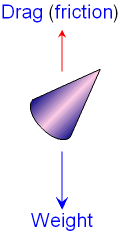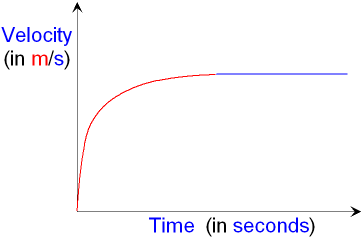
gcsescience.com 23 gcsescience.com
Falling Objects - A Cone Falling from a Cliff.
What are the Forces on a Falling Object?
The forces
on a falling object
are similar to the
flying
rocket
with the direction of the forces reversed.
In this example the falling object
is a cone
but the same forces apply to any falling
object.
Weight is
the force pulling the cone downwards,
Air resistance
(drag) is the force
pushing the
cone upwards.
When the cone first falls, there is a
downward force from the weight of the cone
but very little drag
because the cone is moving slowly and air
resistance is small.
The forces are unbalanced
because there is a
large downward
force but only a small upward force
and so the cone has a large acceleration
in the direction of the
larger force
(downwards)

As the cone gets faster,
the drag increases and acceleration decreases
until the weight and drag are equal in
size.
Now the forces are balanced and the
cone will continue to
fall
with a constant velocity called its
terminal velocity.
What is Terminal Velocity?
The terminal velocity is
the
fastest velocity that
an object can have as it is falling.
The motion of the falling object
is
shown on the velocity -
time graph below.

The red
curve shows the acceleration changing
from large to small.
The blue line shows the terminal velocity of the object.
The terminal velocity is always a constant
velocity.
Calculations for falling objects are on the next page.
![]() Links
Forces and Motion
Force
Revision Questions
Links
Forces and Motion
Force
Revision Questions
![]()
gcsescience.com Physics Quiz Index Force Quiz gcsescience.com
Home GCSE Chemistry GCSE Physics
Copyright © 2015 gcsescience.com. All Rights Reserved.